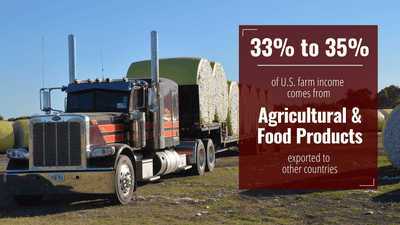September 24, 2021

The Center for North American Studies, CNAS, part of Texas A&M AgriLife, in collaboration with the Texas Department of Agriculture, TDA, is making global market assessments for a number of the state’s agricultural commodities.
“The U.S. is the largest agricultural exporter in the world, and 95% of the world’s population is outside the U.S., so we are helping feed the world,” said CNAS Director Luis Ribera, Department of Agricultural Economics in the College of Agriculture and Life Sciences, Bryan-College Station. “Opening new markets and/or expanding our export share in the world is important to U.S. and Texas producers in that about one-third of U.S. farm income comes from exports.”
The Center for North American Studies meets high-priority national needs to provide objective analyses for rapid, precise responses to emerging trade and international policy issues, Ribera said.
“We have been doing this kind of work for a long time and we are recognized at the state, national and international level for it. We also have a long history of collaboration with TDA and currently have three trade-related projects with them.”
About the commodity assessments
Ribera said the demand for Texas-grown agricultural commodities continues to increase throughout the U.S. and globally.
“To keep up with and further anticipate this growing demand, Texas farmers and ranchers need to be able to understand and adjust to variations in market conditions in an ever-changing world,” he said. “These assessments will provide them with the information they need to be more successful in the global marketplace.”
The commodities for which the CNAS is providing assessments are cabbage, catfish, forest products, grapefruit, melons, mohair, oranges, onions, peanuts, pecans, potatoes, rice, shrimp, spinach and wool. These were chosen by TDA based on their potential for growth and the dearth of global market information currently available on them.
Ribera said the center has completed assessments on 13 of the 15 selected commodities, and assessments for each commodity should be available on the CNAS website by the end of September.
What the assessments provide
Ribera said the assessments offer detailed insights on U.S. export market activity, which can provide Texas producers with a competitive trade advantage.
“This information will not only help Texas producers but could also be of benefit to all U.S. producers of these commodities,” he said. “However, the information in these assessments will particularly help Texas producers take advantage and go after those overseas markets first, giving them an edge on both domestic and international competition.”

Ribera said the TDA asked that the assessments address the challenges and opportunities for Texas exports.
“This research is an objective assessment of future international market-share growth potential for each commodity based on any upward or downward trends and changes in the global marketplace over the past five years or more,” he said.
The assessments will help producers better understand their import and export competitors and trends that reveal challenges in markets, like tariffs, and market variation insights that present opportunities for Texas producers, Ribera said.
“These assessments will help Texas producers who would like to expand their market share or open new markets overseas,” he said. “Basically, they provide an objective overview of the potential for these Texas agricultural products in the global marketplace as well as some of the challenges related to international trade.”
Source: is AgriLife TODAY, which is solely responsible for the information provided and is wholly owned by the source. Informa Business Media and all its subsidiaries are not responsible for any of the content contained in this information asset.
About the Author(s)
You May Also Like




